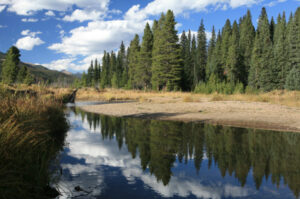(To be a Rhizome guest blogger, contact anelson@biohabitats.com)
The value of the Colorado River is mounting as its reserves diminish. An increasing number of people are beginning to depend on it for their water supply, yet the river is not being replenished at a rate that makes this population growth sustainable. For this reason, many a master of science has devoted their life to increasing knowledge about this area, yet there is still much work to be done in preserving one of the United States’ greatest natural resources. 
Beginning in Rocky Mountain National Park along the edge of the Continental Divide, the Colorado River flows 1,450 miles through seven southwest states to the Sea of Cortez in Mexico. But over the past decade, humans have drained all five trillion gallons of the river’s water before it reaches Mexico, creating a dry delta. About 30 million people depend on the Colorado for water they use to drink, shower, water lawns, cook, and run household appliances—and businesses depend on it as well. Nearly 80% of the water from the Colorado is used in agriculture, to irrigate alfalfa and corn for cattle in Colorado, and farms and orchards in Southern California that grow produce to supply the whole country throughout the year.
If global warming trends continue, there won’t be enough water for any of these purposes. Climatologists say that there are currently drought conditions in 98% of Colorado, due to a warm, dry winter. There, and all along the River, there is concern and a growing effort to conserve water and protect the river, so that the supply of water will not be critically limited.
The Denver Post reports that Governor John Hickenlooper of Colorado responded to the situation by calling for significantly increased water conservation, and saying that more dams would be needed. “We have lessons around the world that we can do more with less,” he said. He was referring to Australia, where city residents cut water consumption to 36 per capita gallons a day, and Israel, which is known for its highly efficient use of water in agriculture. Denver residents have used 20% less water since the 2002 drought, cutting back to 160 gallons a day, but Hickenlooper thinks they can do much better.
Managing water with dams would be an additional way to keep up the supply. There are two rival pipeline projects in the works which would divert 100,000 acre-feet of water from the Colorado basin in Wyoming to Colorado’s Front Range. But an environmental group called “Save the Colorado” is opposed to these projects, saying they would have a negative impact on fish and wildlife, and negative impacts on the recreational and tourist economy in states located downstream. Not to mention, at nine billion dollars, the pipelines would be the most expensive source of water in Colorado history.
Real Aspen reports on a thousands-strong Latino group called Nuestro Rio which is among the many voices calling for protection of the river. They wrote a corrido, or song, calling for policymakers to protect the Colorado. “If we do nothing, the price of water will spike, agriculture and rural communities will become less viable, and households will be forced by utilities and governments to make drastic changes in how they use water,” said a spokesman for the group. They are calling for improved urban conservation of water, improved agricultural efficiency, and “water banks,” which transfer water rights among users to get water where it’s needed most.
Universities are also beginning to chime in as more schools are emphasizing the need to study the Colorado River as well as water management. Water management is a field of study that is growing as quickly as the problem, and programs are offered by both the University of Colorado at Boulder and UCSD. Many believe that with rigorous study and clever problem solving, the Southwest will be able to reverse the deleterious effects consumption has had on the River as well as preventing the problem worsening in the future.
By 2050, climatologists say, the Colorado won’t be able to provide enough water up to 90% of the time. Many believe that it isn’t a question of “if” the Colorado will fall short of the demand, but “when.” And this could spell disaster for millions.
Further Reading
Meet Assistant Construction Project Team Leader Bryan SullivanMeet Conservation Biologist Nolan Schillerstrom
Get to know Allyson Gibson, Biohabitats Extern
Get to Know Graphic Designer Joey Marshall
Evolution: A New Leadership Team for Biohabitats
More From This Author
Make A Difference Week 2022Biohabitats on the Passaic River
Rescuing Polluted Waters: Part 1
Donating Time to Support and Advance Ecosystem Restoration
What if Nature had legal rights?

